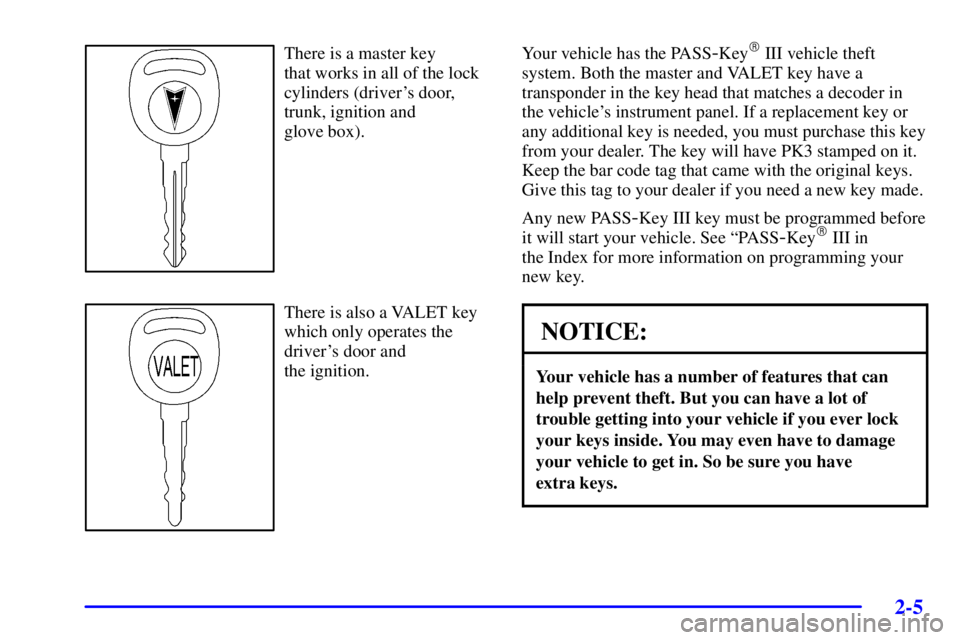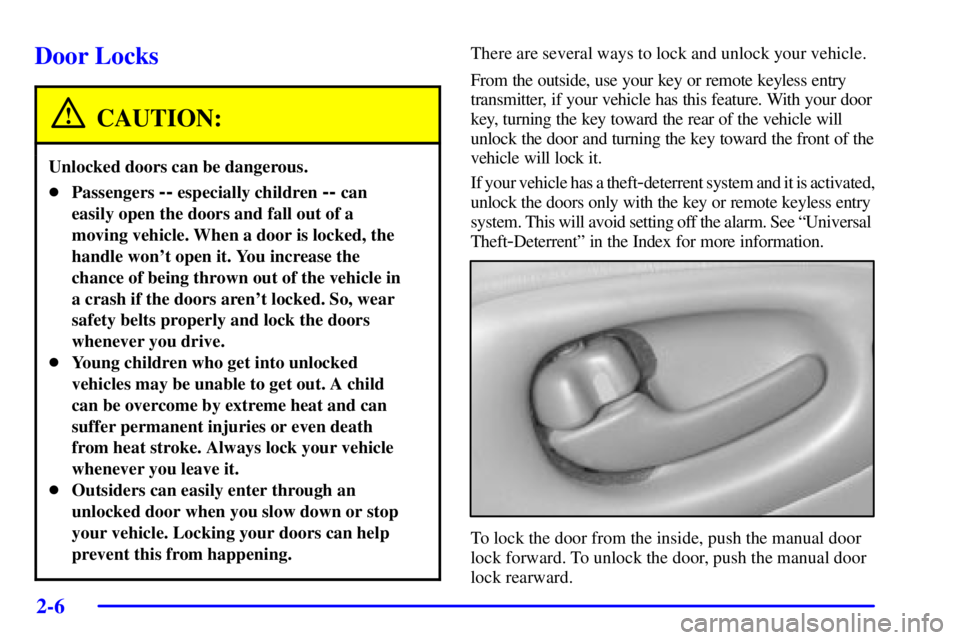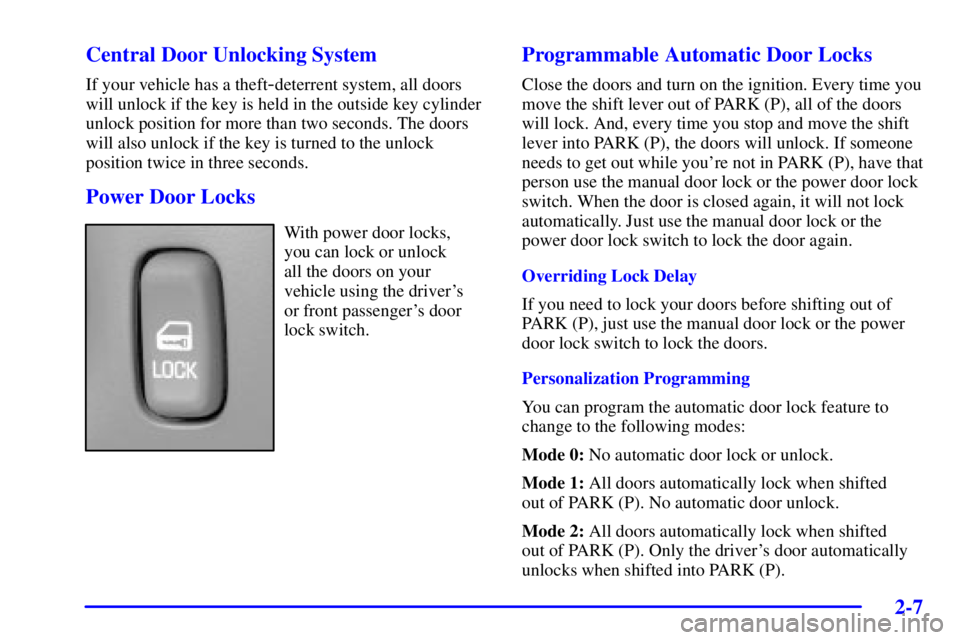Page 4 of 413
Table of Contents
Windows
Keys and Door Locks
Remote Keyless Entry System (If Equipped)
Trunk Release
Automatic Transaxle
Parking Brake
Tilt Wheel
Turn Signal/Multifunction Lever
Windshield Wipers
Cruise Control
Exterior and Interior LampsMirrors
Storage Compartments
Convenience Net (Option)
Accessory Power Outlet
OnStar® System (If Equipped)
Sunroof (Option)
HomeLink® Transmitter (If Equipped)
Instrument Panel, Warning Lights and Gages
Driver Information Center (Option)
Memory and Personalization
Head-Up Display (Option) Seats and Seat Controls
Safety BeltsAir Bag Systems
Restraint Systems for Children
Section
1
Section
2
Seats and Restraint Systems
Features and Controls
ii
Page 33 of 413

1-21
The best way to protect the fetus is to protect the
mother. When a safety belt is worn properly, it's more
likely that the fetus won't be hurt in a crash. For
pregnant women, as for anyone, the key to making
safety belts effective is wearing them properly.
Right Front Passenger Position
To learn how to wear the right front passenger's safety belt
properly, see ªDriver Positionº earlier in this section.
The right front passenger's safety belt works the same
way as the driver's safety belt
-- except for one thing.
If you ever pull the lap portion of the belt out all the
way, you will engage the child restraint locking feature.
If this happens, just let the belt go back all the way
and start again.
If your vehicle has a center passenger position, be
sure to use the correct buckle when buckling your
lap
-shoulder belt. If you find that the latch plate will not
go fully into the buckle, see if you are using the buckle
for the center passenger position.
Air Bag Systems
This part explains the frontal and side impact
air bag systems.
Your vehicle has four air bags
-- a frontal air bag for
the driver, another frontal air bag for the right front
passenger, a side impact air bag for the driver, and
another side impact air bag for the right front passenger.
Frontal air bags are designed to help reduce the risk of
injury from the force of an inflating frontal air bag. But
these air bags must inflate very quickly to do their job
and comply with federal regulations.
Page 42 of 413
1-30 Servicing Your Air Bag-Equipped Vehicle
Air bags affect how your vehicle should be serviced.
There are parts of the air bag systems in several places
around your vehicle. Your dealer and the service manual
have information about servicing your vehicle and the
air bag systems. To purchase a service manual, see
ªService and Owner Publicationsº in the Index.
CAUTION:
For up to 10 seconds after the ignition key is
turned off and the battery is disconnected, an air
bag can still inflate during improper service. You
can be injured if you are close to an air bag when
it inflates. Avoid yellow connectors. They are
probably part of the air bag systems. Be sure to
follow proper service procedures, and make sure
the person performing work for you is qualified
to do so.
The air bag systems do not need regular maintenance.
Center Front Passenger Position
Lap Belt
If your vehicle has a front bench seat, someone can sit in
the center position.
Page 68 of 413

2-
2-1
Section 2 Features and Controls
Here you can learn about the many standard and optional features on your vehicle, and information on starting,
shifting and braking. Also explained are the instrument panel and the warning systems that tell you if everything is
working properly
-- and what to do if you have a problem.
2
-2 Windows
2
-4 Keys
2
-6 Door Locks
2
-11 Remote Keyless Entry System (If Equipped)
2
-16 Trunk
2
-18 Theft
2
-19 Universal Theft-Deterrent (If Equipped)
2
-20 PASS-Key�III
2
-22 New Vehicle ªBreak-Inº
2
-23 Ignition Positions
2
-24 Starting Your Engine
2
-26 Engine Coolant Heater (Option)
2
-27 Automatic Transaxle Operation
2
-30 Parking Brake
2
-31 Shifting Into PARK (P)
2
-34 Shifting Out of PARK (P)
2
-35 Parking Over Things That Burn
2
-35 Engine Exhaust2
-36 Running Your Engine While You're Parked
2
-37 Horn
2
-37 Tilt Wheel
2
-37 Turn Signal/Multifunction Lever
2
-45 Exterior Lamps
2
-47 Interior Lamps
2
-51 Mirrors
2
-54 Storage Compartments
2
-56 Sun Visors
2
-56 Air Inflator System (Option)
2
-61 Express Sunroof (Option)
2
-66 The Instrument Panel -- Your
Information System
2
-72 Warning Lights, Gages and Indicators
2
-89 Driver Information Center (DIC)
(If Equipped)
2
-103 Head-Up Display (Option)
Page 71 of 413
2-4
Keys
CAUTION:
Leaving children in a vehicle with the ignition
key is dangerous for many reasons. A child or
others could be badly injured or even killed.
They could operate the power windows or other
controls or even make the vehicle move. Don't
leave the keys in a vehicle with children.
Page 72 of 413

2-5
There is a master key
that works in all of the lock
cylinders (driver's door,
trunk, ignition and
glove box).
There is also a VALET key
which only operates the
driver's door and
the ignition.Your vehicle has the PASS
-Key� III vehicle theft
system. Both the master and VALET key have a
transponder in the key head that matches a decoder in
the vehicle's instrument panel. If a replacement key or
any additional key is needed, you must purchase this key
from your dealer. The key will have PK3 stamped on it.
Keep the bar code tag that came with the original keys.
Give this tag to your dealer if you need a new key made.
Any new PASS
-Key III key must be programmed before
it will start your vehicle. See ªPASS
-Key� III in
the Index for more information on programming your
new key.
NOTICE:
Your vehicle has a number of features that can
help prevent theft. But you can have a lot of
trouble getting into your vehicle if you ever lock
your keys inside. You may even have to damage
your vehicle to get in. So be sure you have
extra keys.
Page 73 of 413

2-6
Door Locks
CAUTION:
Unlocked doors can be dangerous.
�Passengers -- especially children -- can
easily open the doors and fall out of a
moving vehicle. When a door is locked, the
handle won't open it. You increase the
chance of being thrown out of the vehicle in
a crash if the doors aren't locked. So, wear
safety belts properly and lock the doors
whenever you drive.
�Young children who get into unlocked
vehicles may be unable to get out. A child
can be overcome by extreme heat and can
suffer permanent injuries or even death
from heat stroke. Always lock your vehicle
whenever you leave it.
�Outsiders can easily enter through an
unlocked door when you slow down or stop
your vehicle. Locking your doors can help
prevent this from happening.
There are several ways to lock and unlock your vehicle.
From the outside, use your key or remote keyless entry
transmitter, if your vehicle has this feature. With your door
key, turning the key toward the rear of the vehicle will
unlock the door and turning the key toward the front of the
vehicle will lock it.
If your vehicle has a theft
-deterrent system and it is activated,
unlock the doors only with the key or remote keyless entry
system. This will avoid setting off the alarm. See ªUniversal
Theft
-Deterrentº in the Index for more information.
To lock the door from the inside, push the manual door
lock forward. To unlock the door, push the manual door
lock rearward.
Page 74 of 413

2-7 Central Door Unlocking System
If your vehicle has a theft-deterrent system, all doors
will unlock if the key is held in the outside key cylinder
unlock position for more than two seconds. The doors
will also unlock if the key is turned to the unlock
position twice in three seconds.
Power Door Locks
With power door locks,
you can lock or unlock
all the doors on your
vehicle using the driver's
or front passenger's door
lock switch.
Programmable Automatic Door Locks
Close the doors and turn on the ignition. Every time you
move the shift lever out of PARK (P), all of the doors
will lock. And, every time you stop and move the shift
lever into PARK (P), the doors will unlock. If someone
needs to get out while you're not in PARK (P), have that
person use the manual door lock or the power door lock
switch. When the door is closed again, it will not lock
automatically. Just use the manual door lock or the
power door lock switch to lock the door again.
Overriding Lock Delay
If you need to lock your doors before shifting out of
PARK (P), just use the manual door lock or the power
door lock switch to lock the doors.
Personalization Programming
You can program the automatic door lock feature to
change to the following modes:
Mode 0: No automatic door lock or unlock.
Mode 1: All doors automatically lock when shifted
out of PARK (P). No automatic door unlock.
Mode 2: All doors automatically lock when shifted
out of PARK (P). Only the driver's door automatically
unlocks when shifted into PARK (P).